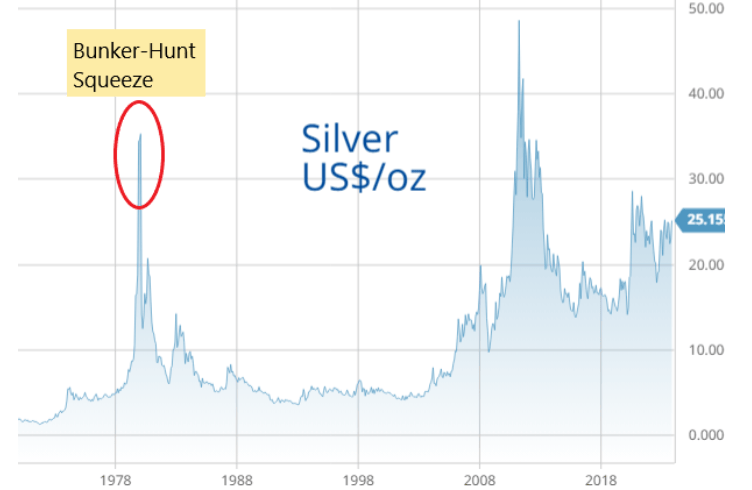PETER STRACHAN: Where is the silver lining?
Experts
Peter Strachan is a capital markets veteran, resources analyst and lover of the oil and gas game. The brains behind the popular weekly StockAnalysis investment letter, which launched in 2003, Peter has worked in capital markets for over 35 years, and is a qualified metallurgist and geologist.
Silver has an interesting and long history alongside human civilisation.
For centuries, silver was struck into coinage to form the backbone of national currencies and still serves as a store of wealth. Wars have been fought and nations conquered to gain access to silver. In the 16th Century, Spanish conquistadores named Argentina for the large amounts of silver that could be found and plundered from that part of South America.
Silver and gold have both stood the test of time as stores of value and both are used for jewellery and sold as an investment product in bars of refined metal.
Silver is seldom mined purely as a primary product. It usually arrives as a by-product of copper, lead, or gold mining. This dynamic means that, unlike gold, whose mined supply can vary with its price, the primary supply of silver is inelastic and varies more in line with the price of its co-product metals.
In the late 1970s, the idea of limited supply flexibility coaxed the Bunker-Hunt Brothers to try and corner the silver market, pushing its price from US$4.50 to highs of US$50/oz.
However, they did not suspect that people would flood into the market to hock grandma’s silverware and jewellery!

Who knows what price gold would need to reach to see so-called ‘buried” supplies come back into the market?
As a store of value, silver has become a poor-man’s gold with about 20-30% of annual production making its way into bars and coins. Gold typically trades within a band of roughly 70 to 90 times the price of silver, so today, it is close to that central point at around US$25/oz.
Following the demise of silver’s industrial use in photography through the ’80s and ’90s, industrial applications in conductive ink electrical circuitry for solar panels has taken off, rising by around 100Moz over the past eight years, while demand is now ramping up by about 20-30 Moz pa in a total market of ~1 billion ounces annually, where a significant deficit of 237Moz was recorded in 2022.
Given an expected exponential rise in the manufacture of solar panels and a low availability of effective substitutes, the place of silver as an investment product seems secure.
Iltani Resources (ASX:ILT) has commenced a 23 RC drill hole programme over three target zones at is Orient silver-lead-zinc-indium project near Herberton, QLD, Australia, before the wet season sets in. Managing director Douglas Garner says that the program aims to extend known mineralisation along strike by intersecting stacked zones of high-grade Ag, Pb, Zn, and indium as well as stockwork silver mineralisation.
Garner points to Iltani’s previous results including 41m grading 125g/t Ag equivalent from 60m downhole and 38m grading 190g/t Ag equivalent from 19m downhole, from mineralisation that also contains lead, zinc, and indium, which currently sells for US$350 per kilogram.
Historical metallurgical test work indicates that Iltani could produce high quality, marketable concentrates of lead-silver and a zinc-indium-silver.
Indium tin oxide thin film coatings are used for electrically conductive purposes in a variety of flat panel displays as well as in night vision equipment, aerospace alloys, solders, and solar cells. A true critical element!
Assay results from the current program should be available for this $4.9 million market capitalisation company in early January ’24.
Argent Minerals’ (ASX:ARD) Kempfield Silver Deposit in NSW, has an estimated Resource of 38.9Mt grading 102.4g/t of silver equivalent, including just over an ounce per tonne of silver, 0.12g/t Au, 0.47% Pb and 1.1% Zn.
Over in Western Australia, recent rock chip sampling at the Copperhead Project, located between Dreadnought’s Yin and Hastings’ Yangibana REE projects, has delivered some spectacular assays, including 25.6% Cu and 52.7g/t Ag and 13.3% Cu with 291g/t Ag, with many samples showing anomalous lead and zinc grades. More samples are in the assay lab, so watch out for these geochemical sampling results which can often point to a story of what REEs, lithium or copper/silver might be hidden below.
The company has a market cap of $13 million and had $1.4 million of cash on 30 September ’23.
Investigator Resources (ASX:IVR) is a $70 million market cap company, preparing a Definitive Feasibility Study over its Paris Silver Project in the north of South Australia’s Eyre Peninsula, where a Mineral Resource of 24Mt grading 73g/t Ag and 0.41% Pb is estimated.
Earlier Pre-Feasibility work from November 2021 estimated a life of mine free cash flow, over a 5–7-year project life, of $487 to $602 million at a silver price of ~US22.65/oz with an AISC of $17.45 (~US$11.5/oz), to produce an NPV of between $202 to $245 million after an initial CAPEX of $131 million.
These numbers will have moved around quite a lot over the past two years, but a silver price of now over US$24/oz will assist the process.
Drilling adjacent to the Apollo deposit in August 2022 delivered one spectacular result of 8 metres grading 1,262g/t Ag from 149m including 3m grading 3,167g/t Ag, which set tongues wagging.
At Stockhead, we tell it like it is. While Iltani Resources is a Stockhead advertiser, it did not sponsor this article.
The views, information, or opinions expressed in the interviews in this article are solely those of the interviewees and do not represent the views of Stockhead. Stockhead does not provide, endorse or otherwise assume responsibility for any financial product advice contained in this article.